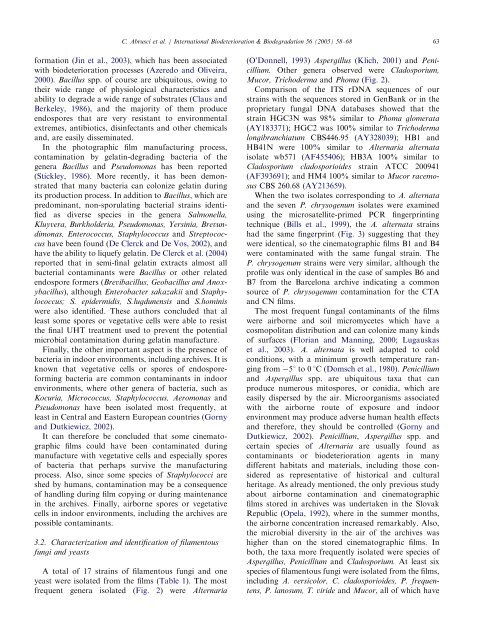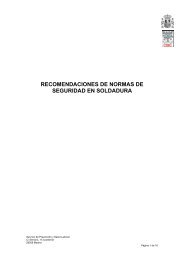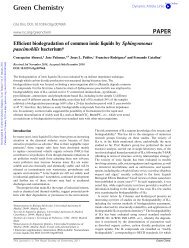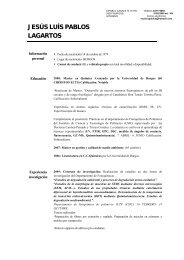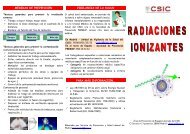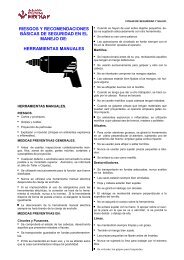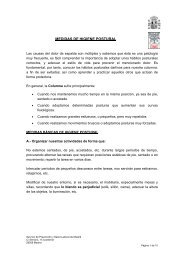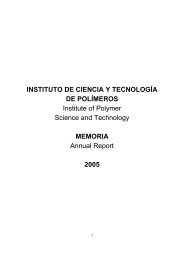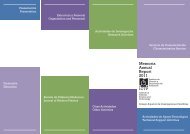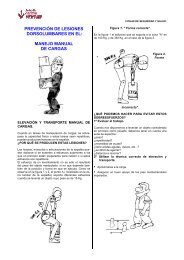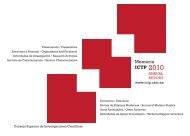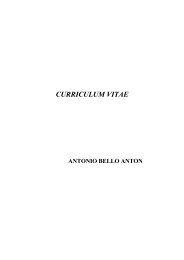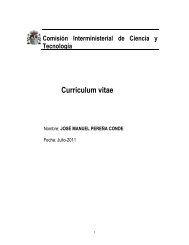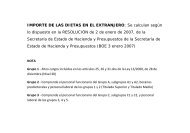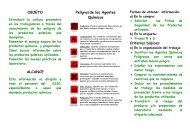Isolation and identification of bacteria and fungi from ... - ictp
Isolation and identification of bacteria and fungi from ... - ictp
Isolation and identification of bacteria and fungi from ... - ictp
- No tags were found...
Create successful ePaper yourself
Turn your PDF publications into a flip-book with our unique Google optimized e-Paper software.
ARTICLE IN PRESS<br />
C. Abrusci et al. / International Biodeterioration & Biodegradation 56 (2005) 58–68 63<br />
formation (Jin et al., 2003), which has been associated<br />
with biodeterioration processes (Azeredo <strong>and</strong> Oliveira,<br />
2000). Bacillus spp.<strong>of</strong> course are ubiquitous, owing to<br />
their wide range <strong>of</strong> physiological characteristics <strong>and</strong><br />
ability to degrade a wide range <strong>of</strong> substrates (Claus <strong>and</strong><br />
Berkeley, 1986), <strong>and</strong> the majority <strong>of</strong> them produce<br />
endospores that are very resistant to environmental<br />
extremes, antibiotics, disinfectants <strong>and</strong> other chemicals<br />
<strong>and</strong>, are easily disseminated.<br />
In the photographic film manufacturing process,<br />
contamination by gelatin-degrading <strong>bacteria</strong> <strong>of</strong> the<br />
genera Bacillus <strong>and</strong> Pseudomonas has been reported<br />
(Stickley, 1986).More recently, it has been demonstrated<br />
that many <strong>bacteria</strong> can colonize gelatin during<br />
its production process.In addition to Bacillus, which are<br />
predominant, non-sporulating <strong>bacteria</strong>l strains identified<br />
as diverse species in the genera Salmonella,<br />
Kluyvera, Burkholderia, Pseudomonas, Yersinia, Brevundimonas,<br />
Enterococcus, Staphylococcus <strong>and</strong> Streptococcus<br />
have been found (De Clerck <strong>and</strong> De Vos, 2002), <strong>and</strong><br />
have the ability to liquefy gelatin. De Clerck et al.(2004)<br />
reported that in semi-final gelatin extracts almost all<br />
<strong>bacteria</strong>l contaminants were Bacillus or other related<br />
endospore formers (Brevibacillus, Geobacillus <strong>and</strong> Anoxybacillus),<br />
although Enterobacter sakazakii <strong>and</strong> Staphylococcus;<br />
S. epidermidis, S.lugdunensis <strong>and</strong> S.hominis<br />
were also identified.These authors concluded that al<br />
least some spores or vegetative cells were able to resist<br />
the final UHT treatment used to prevent the potential<br />
microbial contamination during gelatin manufacture.<br />
Finally, the other important aspect is the presence <strong>of</strong><br />
<strong>bacteria</strong> in indoor environments, including archives.It is<br />
known that vegetative cells or spores <strong>of</strong> endosporeforming<br />
<strong>bacteria</strong> are common contaminants in indoor<br />
environments, where other genera <strong>of</strong> <strong>bacteria</strong>, such as<br />
Kocuria, Micrococcus, Staphylococcus, Aeromonas <strong>and</strong><br />
Pseudomonas have been isolated most frequently, at<br />
least in Central <strong>and</strong> Eastern European countries (Gorny<br />
<strong>and</strong> Dutkiewicz, 2002).<br />
It can therefore be concluded that some cinematographic<br />
films could have been contaminated during<br />
manufacture with vegetative cells <strong>and</strong> especially spores<br />
<strong>of</strong> <strong>bacteria</strong> that perhaps survive the manufacturing<br />
process.Also, since some species <strong>of</strong> Staphylococci are<br />
shed by humans, contamination may be a consequence<br />
<strong>of</strong> h<strong>and</strong>ling during film copying or during maintenance<br />
in the archives.Finally, airborne spores or vegetative<br />
cells in indoor environments, including the archives are<br />
possible contaminants.<br />
3.2. Characterization <strong>and</strong> <strong>identification</strong> <strong>of</strong> filamentous<br />
<strong>fungi</strong> <strong>and</strong> yeasts<br />
A total <strong>of</strong> 17 strains <strong>of</strong> filamentous <strong>fungi</strong> <strong>and</strong> one<br />
yeast were isolated <strong>from</strong> the films (Table 1).The most<br />
frequent genera isolated (Fig.2) were Alternaria<br />
(O’Donnell, 1993) Aspergillus (Klich, 2001) <strong>and</strong> Penicillium.<br />
Other genera observed were Cladosporium,<br />
Mucor, Trichoderma <strong>and</strong> Phoma (Fig.2).<br />
Comparison <strong>of</strong> the ITS rDNA sequences <strong>of</strong> our<br />
strains with the sequences stored in GenBank or in the<br />
proprietary fungal DNA databases showed that the<br />
strain HGC3N was 98% similar to Phoma glomerata<br />
(AY183371); HGC2 was 100% similar to Trichoderma<br />
longibranchiatum CBS446.95 (AY328039); HB1 <strong>and</strong><br />
HB41N were 100% similar to Alternaria alternata<br />
isolate wb571 (AF455406); HB3A 100% similar to<br />
Cladosporium cladosporioides strain ATCC 200941<br />
(AF393691); <strong>and</strong> HM4 100% similar to Mucor racemosus<br />
CBS 260.68 (AY213659).<br />
When the two isolates corresponding to A. alternata<br />
<strong>and</strong> the seven P. chrysogenum isolates were examined<br />
using the microsatellite-primed PCR fingerprinting<br />
technique (Bills et al., 1999), the A. alternata strains<br />
had the same fingerprint (Fig.3) suggesting that they<br />
were identical, so the cinematographic films B1 <strong>and</strong> B4<br />
were contaminated with the same fungal strain.The<br />
P. chrysogenum strains were very similar, although the<br />
pr<strong>of</strong>ile was only identical in the case <strong>of</strong> samples B6 <strong>and</strong><br />
B7 <strong>from</strong> the Barcelona archive indicating a common<br />
source <strong>of</strong> P. chrysogenum contamination for the CTA<br />
<strong>and</strong> CN films.<br />
The most frequent fungal contaminants <strong>of</strong> the films<br />
were airborne <strong>and</strong> soil micromycetes which have a<br />
cosmopolitan distribution <strong>and</strong> can colonize many kinds<br />
<strong>of</strong> surfaces (Florian <strong>and</strong> Manning, 2000; Lugauskas<br />
et al., 2003). A. alternata is well adapted to cold<br />
conditions, with a minimum growth temperature ranging<br />
<strong>from</strong> 51 to 0 1C (Domsch et al., 1980). Penicillium<br />
<strong>and</strong> Aspergillus spp.are ubiquitous taxa that can<br />
produce numerous mitospores, or conidia, which are<br />
easily dispersed by the air.Microorganisms associated<br />
with the airborne route <strong>of</strong> exposure <strong>and</strong> indoor<br />
environment may produce adverse human health effects<br />
<strong>and</strong> therefore, they should be controlled (Gorny <strong>and</strong><br />
Dutkiewicz, 2002). Penicillium, Aspergillus spp.<strong>and</strong><br />
certain species <strong>of</strong> Alternaria are usually found as<br />
contaminants or biodeterioration agents in many<br />
different habitats <strong>and</strong> materials, including those considered<br />
as representative <strong>of</strong> historical <strong>and</strong> cultural<br />
heritage.As already mentioned, the only previous study<br />
about airborne contamination <strong>and</strong> cinematographic<br />
films stored in archives was undertaken in the Slovak<br />
Republic (Opela, 1992), where in the summer months,<br />
the airborne concentration increased remarkably.Also,<br />
the microbial diversity in the air <strong>of</strong> the archives was<br />
higher than on the stored cinematographic films.In<br />
both, the taxa more frequently isolated were species <strong>of</strong><br />
Aspergillus, Penicillium <strong>and</strong> Cladosporium. At least six<br />
species <strong>of</strong> filamentous <strong>fungi</strong> were isolated <strong>from</strong> the films,<br />
including A. versicolor, C. cladosporioides, P. frequentens,<br />
P. lanosum, T. viride <strong>and</strong> Mucor, all <strong>of</strong> which have


